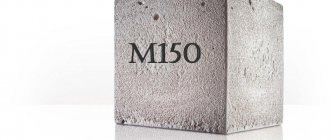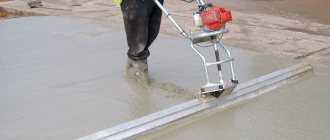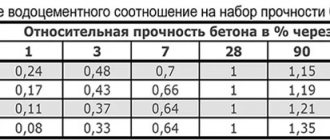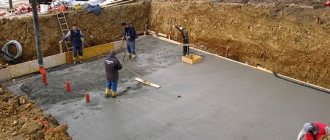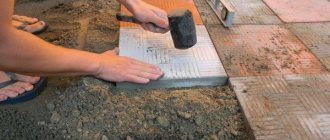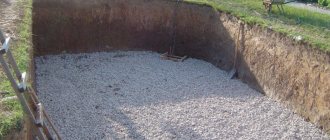In order for concrete not to lose its properties, it must be transported using special machines and maintained at the required temperature. Proper adherence to the temperature regime will create favorable conditions for hardening the mixture, preventing dangerous cracking not only during construction work, but also during the further operation of the entire structure.
Image 1. Concrete curing time table.
This article will discuss what the temperature of concrete should be in order for it to harden and gain the necessary strength.
Temperature of freshly prepared concrete
So, freshly prepared concrete should have a temperature of no more than 30°C. When laying a concrete mixture in ambient air temperatures from +5 to -3°C, its temperature must be at least +5°C. Here it should be taken into account that this temperature indicator, characteristic of a mass of cement of at least 240 kg/m? (grade M200 or more), when using a smaller amount of cement, the temperature of the prepared mixture should be at least +10°C.
Experts consider +15+20°C to be the appropriate temperature environment for hardening. The setting time of concrete, which directly depends on its temperature, can be viewed in the table.
Scheme of hardening of a concrete mixture cone.
Of course, when laying a concrete mixture at a low ambient temperature, its strength increases much more slowly. And if the temperature is below zero, then hardening will practically stop, unless salts are included in the mixture, which can lower the freezing point of moisture.
Concrete that has already begun to harden and then froze will continue to harden after thawing in a warm environment only if it was not damaged by freezing water at the beginning of its hardening. According to experts, one-time freezing of concrete and, accordingly, its thawing is allowed only if the temperature of the concrete mixture has been maintained at least +10°C for at least 72 hours.
When concreting at elevated ambient temperatures, concrete hardens much faster, this is especially true in conditions of high humidity. Heating the concrete mixture to a temperature of more than 80°C leads to its rapid drying. The only exception is the processing of concrete with saturated steam in a specially sealed chamber with a temperature of 90-100°C or the manufacture of products in factories in an autoclave under pressure.
Winter period
There is one main requirement for laying a concrete mixture in the cold winter season - the concrete must acquire strength sufficient for stripping, full or partial load of the structure. The consequence of freezing the concrete mixture at the initial stage is a significant reduction in its strength after thawing occurs.
This phenomenon occurs due to the fact that freshly prepared concrete is saturated with moisture, which freezes and expands at low temperatures, resulting in a breakdown of the bond between the weakly set cement stone and the surface of the aggregates.
Shrinkage chart when concrete dries.
In addition, when constructing reinforced concrete structures, early freezing of the concrete mixture will significantly reduce its adhesion to metal reinforcement.
When performing concrete work in winter, it is necessary to ensure that the concrete mixture hardens in a humid and warm environment for a certain time. This can be achieved in two ways:
- application of internal concrete temperature;
- additional heat supply.
In the first method, you need to use fast-hardening and high-strength Portland cement. Experts recommend using various cement hardening accelerators, for example, calcium chloride. Thus, accelerating the hardening of the concrete mixture is achieved by reducing the amount of water, adding air-entraining and plasticizing additives to it, as well as using a high-frequency vibrator during laying.
Carrying out all these measures will certainly speed up hardening and make it possible to achieve sufficient strength of the concrete mixture before it freezes.
The reserve of internal heat is created by heating the materials that make up the concrete mixture; in addition, heat is released in hardening concrete as a result of the chemical reaction that occurs between water and cement (cement exotherm).
You should know that to mix the concrete mixture, you can heat only water or water and components (crushed stone, gravel, sand). Water is heated to 90°C, fillers – to 40°C.
Transporting concrete mixture
Transporting a concrete mixture means delivering it (horizontal transport) from the concrete plant to the object being concreted and delivering it (vertical transport) to the place of placement.
The concrete mixture is transported from the concrete plant to the object being concreted using means that ensure the required concreting rates.
In order to avoid disruption of the homogeneity of the mixture and unnecessary labor costs, it is most advisable to transport the concrete mixture to the laying site using the same equipment (for example, dump trucks) without overloading. However, in most cases, the mixture at the site has to be reloaded and supplied to the place of installation with other equipment (for example, taps in buckets, trunks, vibrating robots).
Regardless of the accepted methods of transportation, the mobility or rigidity of the concrete mixture at the installation site must correspond to the design. To do this, it is necessary to take measures to reduce the time of delivery and supply of concrete mixture from the place of preparation to the place of placement. During transportation, the homogeneity of the concrete mixture must not be allowed to be disturbed, i.e., it should delaminate (crushed stone or gravel settles down, and separated cement laitance and water appear on the surface). The laminated concrete mixture must not be placed in concrete structures; it must be mixed again until uniformity is completely restored. At the same time, it is necessary to find out the reasons for the delamination of the concrete mixture and take measures to eliminate them.
Incorrectly selected concrete mixtures with excess water delaminate especially easily. The mixture usually separates from shocks and shocks during loading, transportation or unloading from a great height.
Bulk transportation of concrete mixture in the bodies of on-board vehicles is prohibited, since in this case losses of cement laitance and cement mortar are inevitable, and, consequently, a violation of its homogeneity.
The permissible duration of transportation must be established in each individual case by the laboratory, depending on the setting time of the cement used and the outside temperature.
For lightweight concrete mixtures based on porous aggregates, the duration of transportation of the concrete mixture should not be more than 45 minutes, and for a duration of more than 30 minutes it is recommended to use concrete mixer trucks.
During transportation from the concrete plant to the place of placement, the concrete mixture is protected from precipitation and protected from drying out.
It is advisable to supply the concrete mixture to all areas of the structure being concreted without additional overloads and with as little transfer as possible; the height of its free fall when fed into the structure should not exceed 2 m.
When concreting columns without intersecting reinforcement clamps with cross-sectional sides from 0.4 to 0.8 m, the drop height is allowed no more than 5 m. If it is necessary to supply concrete mixture from a greater height in places where it is impossible to lower the bucket with a crane, vibrating chutes, inclined trays, vertical trunks, and at a height of more than 10 m - vibration trunks with dampers. Vibrating robots with dampers can also be the main means of supplying concrete mixture when concreting from overpasses.
- Concrete science
- Manufacturing technology of prefabricated reinforced concrete structures and parts
- General issues in precast concrete production
- Preparation of concrete mixtures
- Production of mortar mixtures
- Transportation of concrete mixture Delivery of concrete mixture
- Equipment for supplying and distributing concrete mixture
- Safety precautions
- Preparation of reinforcement
- Formwork
- Preparing molds, forming concrete and curing products
- Reinforcement and forming of prestressed products
- Features of the production of various types of concrete and reinforced concrete products
- Concreting of various structures
- Concrete work in winter conditions
- Production of prefabricated structures and parts from lightweight concrete
- Production of prefabricated products from dense silicate concrete and concrete with clinker-free binder
- Production of concrete and reinforced concrete products at landfills
- General safety rules and fire prevention measures at a construction site
Heating of concrete
Table of accelerators and retarders for concrete mixtures.
It should be taken into account that the temperature of the mixture when unloading from the concrete mixer should be no more than 30°C, since at a higher temperature it will simply harden and lose the mobility necessary for laying. You should also know that it is not recommended to add water to the prepared mixture, because this leads to a decrease in its strength.
Immediately before placing concrete into the structure, it can be heated in a special bunker - using electric heating. An electric current penetrates the concrete mixture, and it heats up to a temperature of 50-70°C.
The heated mixture should be placed immediately, as it thickens quite quickly. The hardening process takes 3-7 days, and the concrete will release a significant amount of heat. In order to retain this heat for a while, the formwork and its open areas must be covered with good insulating material (mineral wool, shevelin, sawdust, etc.). This method is called a thermos. Experts recommend using this method of heating the concrete mixture for the construction of structures with medium thickness.
There is heating of concrete using steam. Water vapor is passed through the middle of the double formwork that surrounds it, or through tubes located inside the concrete mixture. Steam can also be passed through channels that are cut out in advance on the inside of the formwork. As a rule, the steam temperature ranges from 50 to 80°C.
Heating the concrete mixture with steam allows it to harden in a relatively short time (2 days).
Electrode plates
Scheme of processes during hardening of concrete mass.
This heating method uses alternating current. Special steel electrode plates are connected to electrical wires and placed on the side or top of the structure at the initial stage of concrete setting. Longitudinal electrodes or short steel rods can also be used, which are driven into concrete and then connected to electrical wires. After the concrete has hardened, the ends of the rods are simply cut off.
Electrode plates are used, as a rule, for heating slabs and walls, transverse steel rods and longitudinal electrodes are used for heating columns and beams.
At the initial stage of warming up, it is necessary to supply current with a low voltage (50-60 V). The freshly laid concrete mixture is heated and hardened when electricity passes through it. It should be noted that heating must be done very slowly, this will avoid premature drying of the concrete and the appearance of cracks in it. The temperature of the concrete mixture is increased by no more than 5°C/h, in this way it is necessary to bring its temperature to 60°C. With this method of heating the concrete mixture, it will gain the necessary strength within 1-2 days of hardening.
Heating a concrete mixture can be done by heating the air that surrounds it. To do this, you need to create a canvas or plywood greenhouse in which to build a temporary oven (gas burner, heater, etc.). A vessel with water is placed in the constructed greenhouse to create a humid environment. This method is much more expensive than the previous one and is used at very low temperatures and small volumes of concreting.
Concrete work in extreme conditions
Low temperatures
The peculiarity of working in such conditions is that concrete sets more slowly at low temperatures. To gain the strength specified in the regulatory documentation, the monolith needs more time.
For example:
- When the thermometer readings during the day are about + 5 oC, the finished structure hardens twice as much as under normal conditions.
- When the air at a construction site cools down to 0 ° C, the process of hardening and strength gain practically stops.
- If the newly laid concrete mixture freezes (which happens if the technology for its production or transportation is not followed), the monolith may completely collapse.
Destruction of concrete due to freezing of water in it
The water contained in the solution crystallizes at subzero temperatures, resulting in the formation of voids and pores in the concrete, which reduce the strength of the concrete product. In addition, ice exerts increased pressure on the walls of the concrete structure.
Cracks and splits may form in the finished monolith. In addition, frozen water breaks the bonds between cement and concrete aggregate (crushed stone, gravel, etc.).
The maturation of concrete at low temperatures must be completed before freezing.
Otherwise, two negative points appear at once:
- the finished structure will not be able to gain the strength required by the grade of concrete mixture;
- After thawing, hardening will not occur correctly and there is a possibility of destruction.
In order to continue work during the cold season, it is necessary to use special grades of concrete and appropriate additives. They will not only improve the quality of the monolith, but also reduce the hardening time.
Let's consider a table compiled in accordance with SNIP 3.03.01-87, which shows the hardening time of various grades of concrete depending on the ambient temperature.
Brand Strength Number of days at a temperature of +5 oC Number of days at a temperature of +10 oC Concrete with additives 20 4 3 M400 30 6 4 M150 – M350 40 9 6 M100 50 14 10 Concrete in a water-saturated state 70 25 20
You can improve the quality of concrete in the cold season in the following ways:
- when producing concrete, use cement that promotes rapid strength gain by the finished monolith;
- increase the percentage of cement in the finished construction mixture;
- reduce the amount of water added to the solution;
- preheat raw materials (up to +35 °C) and water (up to +70 °C) - this requirement is regulated by SNiP 3.03.01-87;
- use antifreeze additives for concrete (their price is low, and therefore does not increase the estimated cost of construction too much).
Photo of hardening concrete in the foundation after pouring
High temperatures
After the concrete is laid at the construction site, due to the action of water on the cement powder, the hardening of the solution begins. Hot weather speeds up this process. However, if this indicator rises above +25°C (concrete drying temperature), expansion of the building mixture occurs, which is recorded after the completion of the hardening process.
Later, after cooling, the concrete monolith begins to shrink, which is prevented by the resulting solid structure. The result is the appearance of shrinkage cracks and deformation. This process can last up to 12-16 hours, which has an extremely negative effect on strength.
Polyethylene prevents premature evaporation of moisture from concrete
If the weather forecast at the construction site indicates an increase in air temperature above +25 ° C over the next few days, it is necessary to slightly change the composition of the concrete mixture.
To do this you need:
- use quick-hardening cement, the grade of which is 1.5-2 times higher than the recommended one;
- add plasticizing additives or substances that slow down the hardening process to the finished solution;
- work in the morning, evening and night, when the air temperature does not rise above + 20 ° C.
Advice! When carrying out work in hot weather, it is advisable to protect fresh concrete from exposure to wind and direct sunlight. In addition, it is recommended to moisturize the surface to promote proper hydration.
Use of antifreeze additives
There is also a cold method of concreting in winter conditions. This method does not involve heating the concrete mixture materials. Its essence is to add a large amount of salts to the water: calcium chloride, potash, sodium nitrite, sodium chloride. These salts can lower the freezing point of moisture and provide the concrete mixture with the necessary conditions for gaining strength in the cold. But here it should be taken into account that concrete prepared with the addition of potash hardens very quickly, and rapid setting leads to difficulties in laying it in formwork. Therefore, for the convenience of working with concrete in which this additive is present, sulfite-yeast mash or soap naft is added.
The simplest and most economical option for using concrete in winter is to mix the concrete mixture with the addition of antifreeze additives. But there are also disadvantages here, for example, a large number of chemical elements (salt) worsens the structure of the concrete mixture, and this leads to a decrease in the durability of the structure.
When operating a structure in a humid environment, corrosion of the reinforcement may occur due to exposure to chloride salts. You should know that the use of sodium nitrite and potash for mixing concrete mixtures does not cause corrosion.
Experts do not recommend using concrete, the preparation of which includes anti-frost additives, for the construction of critical concrete structures and in structures that will be used in a humid environment.
Behavior of concrete when exposed to open fire
The building material in question is extremely fire-resistant, which has been one of the many factors contributing to its popularity. The melting point of concrete, for example, is about + 1200 °C (depending on the brand and aggregate).
In addition, the appearance of concrete structures during a fire helps to determine the temperature of the flame and choose the appropriate fire extinguishing method:
- The temperature is about + 300 oC - the artificial stone acquires a pinkish tint, and a significant layer of soot and combustion products settles on the surface.
- Temperature from +400 oC to + 600 oC – the concrete takes on a red tint, soot burns off the surface of the monolith.
- Higher temperature - the structure becomes pale gray.
The destruction of concrete during combustion is usually calm. The expansion coefficient of the fillers included in it is in a wide range, as a result of which the adhesion of crushed stone or gravel to cement powder is destroyed gradually, starting at +300 ° C.
Concrete is a very fire-resistant material
If heating continues, cracks appear in the structure of the monolith, which gradually expand until the structure loses its integrity.
